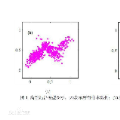Gaussian mixture models form a flexible and expressive parametric family of distributions that has found applications in a wide variety of applications. Unfortunately, fitting these models to data is a notoriously hard problem from a computational perspective. Currently, only moment-based methods enjoy theoretical guarantees while likelihood-based methods are dominated by heuristics such as Expectation-Maximization that are known to fail in simple examples. In this work, we propose a new algorithm to compute the nonparametric maximum likelihood estimator (NPMLE) in a Gaussian mixture model. Our method is based on gradient descent over the space of probability measures equipped with the Wasserstein-Fisher-Rao geometry for which we establish convergence guarantees. In practice, it can be approximated using an interacting particle system where the weight and location of particles are updated alternately. We conduct extensive numerical experiments to confirm the effectiveness of the proposed algorithm compared not only to classical benchmarks but also to similar gradient descent algorithms with respect to simpler geometries. In particular, these simulations illustrate the benefit of updating both weight and location of the interacting particles.
翻译:Gausian 混合物模型形成一个灵活和直观的分布式参数组合,在多种应用中都找到了应用。 不幸的是,从计算角度来说,将这些模型与数据相匹配是一个臭名昭著的难题。目前,只有基于瞬间的方法才享有理论保障,而基于可能性的方法则以简单例子中已知无法做到的超常方法为主。在这项工作中,我们提出了一个新的算法,用以计算高斯混合模型中非对称最大可能性估计值(NPMLE),我们的方法以瓦瑟斯坦-菲舍尔-拉奥测得的概率测量空间的梯度下降为基础,我们为此建立了趋同保证。在实践中,可以使用相互作用的粒子系统进行近似,在这种系统中,粒子的重量和位置可以互换更新。我们进行了广泛的数字实验,以证实拟议算法的有效性,不仅与经典基准相比,而且与较简单的地貌模型类似的梯度测算法。特别是,这些模拟表明更新了相互作用粒子重量和位置的好处。




